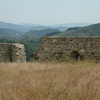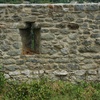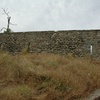Castelvecchio - Castle of Sala
The fortress of Castelvecchio is located on high land on the right bank of the river Serchio, which separates it from the peaks of Mount Croce and the village of San Donnino. The layout of irregular elongated fort closely follows the lay of the land. The remains of the defensive structure consist in a perimeter of thick walls of local stone that rise from the ground to a limited height compared to the original.
Access to the castle was through a single entrance, located on the south side, and fitted with a small avant-corps. The architectural complex was to play a decisive role in the defence of the territory, thanks to its position and the relative inaccessibility of the fort. Despite this, the site was abandoned in the early Renaissance period and was used as a agricultural store.
Historical notes
The first documentation of the existence of a fortification on the high ground of Sala, then known as Castrum Vetus, is in an Imperial Diploma of 23th March 1164 in which Frederick I confirmed the rights held by the Bishop of Lucca to “l’arcem que vocatur Sala, cum burgo et cappella atque plebem de Castello”, or “the fortress called Sala, the borough and the chapel as well as the people of the Castle”.
An act of 1st December 1179, the only private document of the twelfth century pertinent to the territory of High Garfagnana, is an agreement on the sharing of the “Old Castle”, the “summitate Castriveteris que dongionem appellatur”, between the Bishop of Lucca, Cunimondo et Superbo dei Filii Guidi and Ugone Count of Lavagna.











